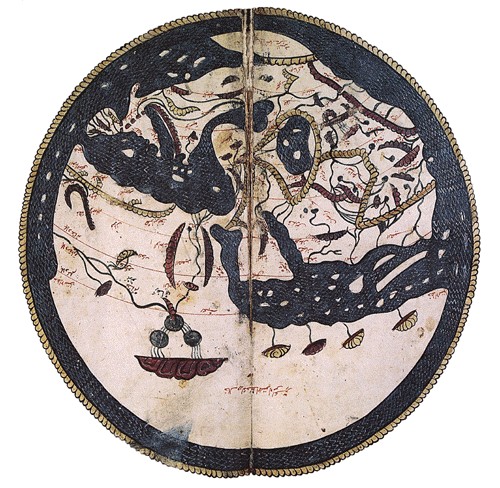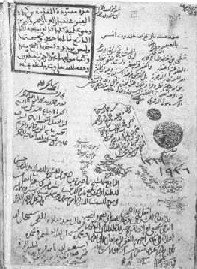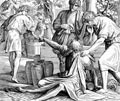

Back to Table of Contents 4
To next page
Ibn Khaldun (1332-1406) Al-Muqaddim
(about universal history) born in Tunisia, worked in Egypt
---------------------------------------------------
Taken from: The Muqaddimah: Transl. Franz Rosenthal
Also called: Ibn Khaldun, Ibn Haldun, Ibn Khaldoun: Al Makkadima, Al Makaddima
The book is also called : Prolegomenes de l'Histoire des Berbers.
The extracts given all come from different places in the book. Every paragraph comes from a different section. But I kept the sequence.
From the Surrounding Sea, they say, a large and wide Sea flows on the east at 13 deg. north of the equator. It flows a little towards the south, entering the first zone. Then it flows west within the first zone until it reaches the country of the Abyssinians and the Negroes and Bab al-Mandeb in the fifth section of the first zone, 4,500 parasangs from its starting point. This sea is called the Chinese, Indian, or Abyssinian sea. It is bordered on the south by the country of the Zendjs and the country of Berbera which Imru'ul-Qays mentioned in his poem. These Berbers do not belong to the Berbers who make up the tribes in the Maghrib. The sea is then bordered by the town of Maqdachou, the land of Sofala, the places of the Quaq-Quaq and other people, after which there is nothing then deserts and waste. On the north where it starts it is bordered by China then Eastern and Western India and then by the coast of Yemen-that is al-Ahqaf, Zabid, and other cities. Where it ends, it is bordered by the country of the Zendjs and beyond them the Beja.
If you have to name ten seas (instead of eight) you add the ones of the eastern sea: the sea of India and the sea of the Zang.
According to al-Gayhani, the Nil starts in the mountains of the moon, then on the other side of the equator flows into two lakes, then describes a circle around Nubia. Other authors state that we do not know its beginnings and that nobody knows where it comes from.
The Nile begins at a large mountain, sixteen degrees beyond the equator at the boundary of the fourth section of the first zone. This mountain is called the Mountain of Qumr. No higher mountain is known on earth. Many springs issue from the mountain, some of them flowing into one lake there, and some of them into another lake. From these two lakes, several rivers branch off, and all of them flow into a lake at the equator which is at the distance of a ten days journey from the mountain. From that lake, two rivers issue. One of them through Egypt... The other river turns westward, flowing due west until it flows into the surrounding sea.
The Nil springs from a big mountain at 16 deg. of the Equator and under the meridian that goes through the fourth part of the first climate. It is called the Mountain of Komr and it is the highest in the world.
That river (Nil) comes from the mountain of al-Komr 16 deg. south of the equator. People disagree on the pronunciation. Some say al-Kamar, they think the mountain got its name from the moon, because it is very white. In the Mostarik Yakut writes al-Komr which is also the name of a people in India. Ibn Said uses this last way of writing.
From that mountain come ten springs, of which five flow into one lake, and the five others in a second lake. Out of each lake flow three rivers. Those rivers flow together in a swampy lake (batiha), on the foot of which emerges a mountain that cuts the northern shore of the lake and divides the waters into two branches. The western one flows west, in the land of the blacks, and winds up throwing itself into the ocean. The eastern one goes north, through Abyssinie and Nubie and the places in between.
Abyssinie is situated in the middle of the first part of the world in the fifth section. Through it flows a river, coming from the other side of the equator, running towards Nubia where it runs into the Nile, and from there descends into Egypt. After the equator it has passed close to Mogadisco, on the southern shores of the ocean. Many people have fantastic ideas about this river, and believe that this river is part of the Nile of Al-Qumr. But Ptolemy wrote in his geography that it has nothing to do with the Nile.
To the south of Zayla, on the western shores of the Indian Ocean, are spread out the villages of Berbera, following the southern coast all the way to the VI section. In the east they touch the land of the Zanj. Then there is the town of Mogadiscio (Maqdashu) which is overfilled with people and its standard of civilization is that of nomadic people. One also finds lots of merchants there. To the east of Makdasau is the land of Sofala, which is on the southern shore of this sea, in the seventh section of this first climate. Then to the east of Sofala on the same coast you find the land of Wakwak, that stretches uninterrupted till the end of the 10th section of the climate there where the Indian ocean and the surrounding sea meet.
There are many islands in the Indian ocean. The biggest is Sarandyb, it has a rounded form and encloses a well known mountain, the highest in the world. This island is opposite Sofala. After that comes the island of Komar, which is long and starts opposite Sofala, and goes east and north, that way it comes close to China. To the south of it is the island of wakwak...
Some genealogists who had no knowledge of the true nature of beings imagined that the blacks are the descendants of Ham, the son of Noah, and that they were characterized by black color as a result of a curse put upon them by his father (Noah), which manifested itself in Ham's color and the slavery that God inflicted upon his descendants. Concerning this they have transmitted an account arising from the legends of the story-tellers. The curse of Noah upon his son is there in the Torah. No reference is made there to blackness. His curse was simply that Han's descendants should be the slaves of his brothers' descendants. To attribute the blackness of Negroes to Ham, shows disregard for the nature of heat and cold and the influence they export upon the air and upon the creatures that come into being in it.
The inhabitants of the first and the second zone in the south are called the Abyssinians, the Zanj, the Sudanese. These are synonyms used to designate the particular nation that has turned black. The name Abyssinians however is restricted to those Negroes who live opposite Mecca and the Yemen and the name Zanj is restricted to those who live along the Indian Ocean. These names are not given to them because of an alleged descent from a black human being, be it Ham or anyone else. Negroes from the south who settled in the temperate fourth zone or in the seventh zone that tends towards whiteness, are found to produce descendants whose color gradually turns white in the course of time.
When genealogists noted differences between the nations their distinguishing marks and characteristics, they considered these to be due to their different descents. They declared all the Negro inhabitants of the south to be descendants of Ham. They had misgivings about their color and therefore undertook to tell the aforementioned silly story.
Distinction between races and nations are in some cases due to different origin, as in the case of the Arabs, the Israelites and the Persians. In other cases, they are caused by geographical location and physical marks, as in the case of the Zanj, the Abysinians, the Slavs, and the Sudanese Negroes. Again in other cases, they are caused by custom and distinguishing characteristics, as well as by descent, as in the case of the Arabs. Or they may be caused by anything else among conditions, qualities, and features peculiar to the different nations.
We have seen that Negroes are in general characterized by levity, excitability and great emotionalism. They are found eager to dance whenever they hear a melody. They are everywhere described as stupid.
Masoudi took it upon him to look for the cause that produces by the Negroes that light handedness, the constant pleasure they radiate, but for all solutions there is only a word from Galen and Al-Kendi after whom their character goes towards a feeble brain, from where comes feeble intelligence. Their words do not prove anything and are without value.
The black nations are as a rule, submissive to slavery, because ( blacks) have little (that is essentially) human and have attributes that are quite similar to those of dumb animals, as we have stated.
---------------------------------------------------------------------------------------------------------------------------

Taken from the original translation
The blacks are made up from different races, people and different tribes. In the east, the best known are the Zanj, the Abyssins and the Nubians, As to the western ones, we will talk about them after the general genealogy of the blacks.
The blacks are descendants of Cham, son of Noah, The Abyssins come from Habash, son of Kush, son of Cham; The Nubians, the Nuba son of Kush, son of Canaan, son of Cham, according to al-Masudi, or from Nub, son of Qut, son of Micr, son of Cham, according to Abd al-Barr; The Zanj, from Zanji, son of Kush. All other blacks descent according to Ibn Abd al-Barr, of Qut, son of Cham, or according to an other opinion, from Qubt, son of Cham.
Ibn Said lists 17 nations of black tribes.
In the east, on the Indian Sea, one finds the Zanj, who have a town called Munbaca. They are idolaters. A certain amount of slaves taken from their country had rebelled against there masters in Basra and followed a Shiite predication under the reign of the caliph al-Mutamid.
Besides them one finds the Barbara, of which the poet Imru'u-l-Qays speaks in his verses. Islam is nowadays very extended among them. They have a town on the Indian ocean called Mogadishu, which is often visited by Muslim merchants.
In the south east of those people one finds the Demadim, who are naked and without shoes. They invade Abyssinia and Nudia, says Ibn Said, in the days that the Tartars enter Iraq. After having devastated this country they returned home....
Further away there are the Nubians, brothers of the Zanj and the Abyssins. They owe on the left side of the Nil river the town of Dongola.....
Taken from B.G. Martin: African Historical Studies 1974. This section only appears in one manuscript (the Egyptian edition)
The population of Shash or Chach (now Tashkent) in Central Asia was ordered to evacuate the town around 604 AH (1207-1208AD) by the Khwarizmshah Qutb al-Din Muhammad II. Chach lay in the path of an invading force of Qara Khitay Turks. these refugees, many of them skilled weavers and cap-makers, dispersed into the lands of Islam.... to Cairo, Baghdad, and Mogadishu.